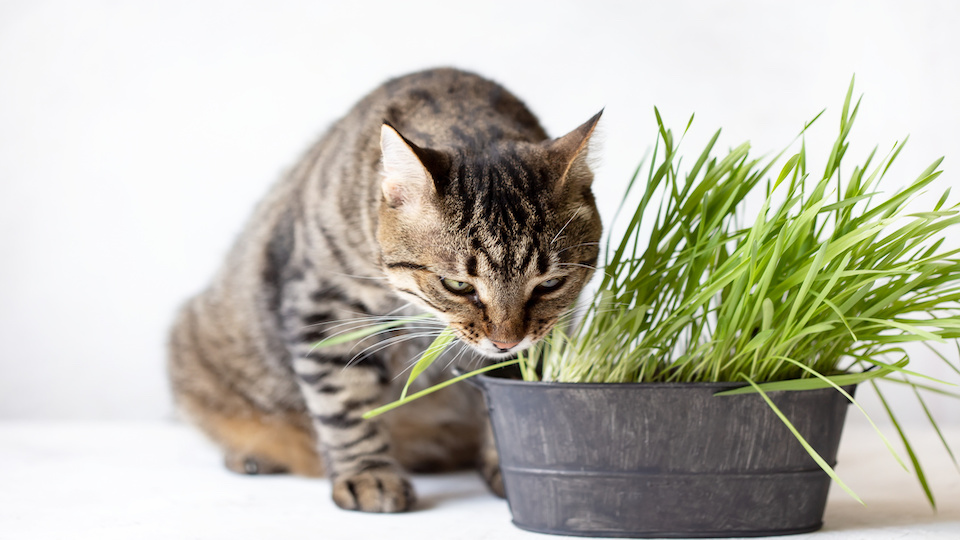Though cats are carnivores and love eating meat and fish-based foods, you may have noticed your feline friend snacking on grass or chewing up your houseplants. If you have an indoor/outdoor cat, you’ve probably seen them rolling around in the yard munching on blades of grass like any hungry vegetarian. If your cat stays inside all day (like most domestic cats), you’ve probably had to place your plants on shelves out of their reach due to voracious snacking. Don’t worry! This behavior is totally normal and may even have health benefits. However, it is crucial to provide the right kind of foliage to protect your precious feline. So why does your cat eat grass, and how can you grow your own? Read on to find out.
Why cats eat grass
The exact reason behind the grass-eating habits isn’t exactly known; however, there are a few theories that stem from ingrained behaviors before the species was domesticated. Cats in the wild eat grass after catching and eating prey, so animal behaviorists believe that this is their instinctual method of inducing vomit to help dispell the indigestible parts of their meal. It may also be a form of fiber that could help your cat pass a hairball or relieve digestive upset.
Other theories suggest that cats snack on grass for trace minerals and nutrients such as vitamins A and D. Grass is also a natural source of folic acid which aids in the production of hemoglobin, the protein that moves oxygen in the blood and can improve circulation. Chlorophyll is another beneficial component of grass and could help with pain, infection, ulcers, skin diseases, and anemia similar to the benefits of antibiotics.
Reasons to grow cat grass indoors
Indoor cats don’t have access to the yard and are unable to perform instinctual cat behavior, so they may become destructive and begin eating houseplants. This is not only bad for your plants, but could seriously harm your cat since many houseplants are toxic to pets. Grow your cat their own grass in an easily accessible place and keep your houseplants out of reach and check to make sure that you are growing pet-safe plants.
While outdoor cats may have access to grass, it isn’t necessarily good for them. Lawns are often treated with a variety of chemical fertilizers, weed killers, pesticides, and other dangerous substances. Even if you don’t lace your own lawn with toxins, you have no idea what your neighbor is using. Providing a green snack indoors will encourage your cat to eat that instead of harmful pesticide grass and potentially poisonous flowers.
How to grow cat grass
Most pet stores have easy-to-grow cat grass kits that usually just involve adding water. However, you can also go the DIY route by following a few simple steps.
- Get your container: Look for a low, heavy container that will be difficult for your cat to tip over.
- Fill it ¾ of the way full with potting soil and sprinkle seeds over the surface. Mist them with a spray bottle as you add them. Cover with ¼” of soil.
- Cover loosely with plastic wrap while the seeds germinate and keep it out of direct sunlight.
- After a few days, when sprouts appear, remove plastic and place in a sunny spot such as a windowsill and keep the soil moist.
- Give your cat access to the grass when the blades are around 4” tall. Usually 10-14 days after planting.
- Mist with a spray bottle every day, but don’t let water sit in the container as this could cause mold.
- The grass will wilt after a few weeks. Pull out the shoots and plant new seeds. It is a good idea to have two pots with staggered growing times so that your kitty will always have access to fresh cat grass.
Best grass for your cat
Cat grass isn’t actually a type of plant, but rather a name for regular grass grown indoors for your pet. Cat grass kits will often have a mix of wheat, oat, barley, and rye seeds to give your cat some variety and provide essential nutrients. Veterinarians also love alfalfa since it has the added benefit of preventing and treating kidney disease. It may be a good idea to grow a combination of these grasses or mix it up every few months to keep things interesting for your feline friend.
Word of caution
Keep an eye out for overeating. Munching on the grass is normal, but if your cat is eating entire blades within a week or two, there may be an underlying health concern or dietary imbalance. Always take your cat to the vet if you notice any unusual behavior or concerning symptoms.
-Taylor Ramsey




